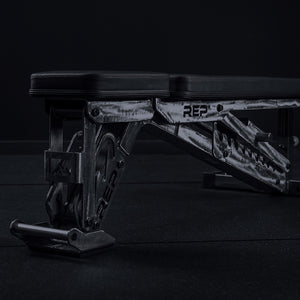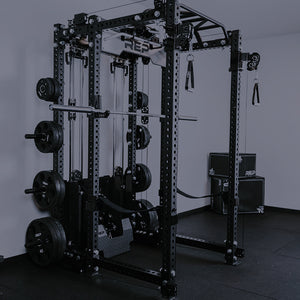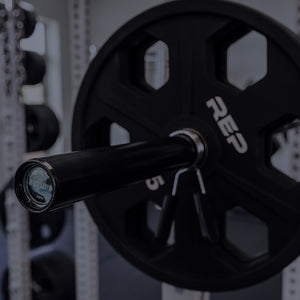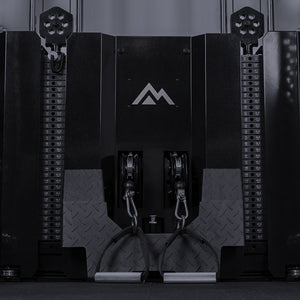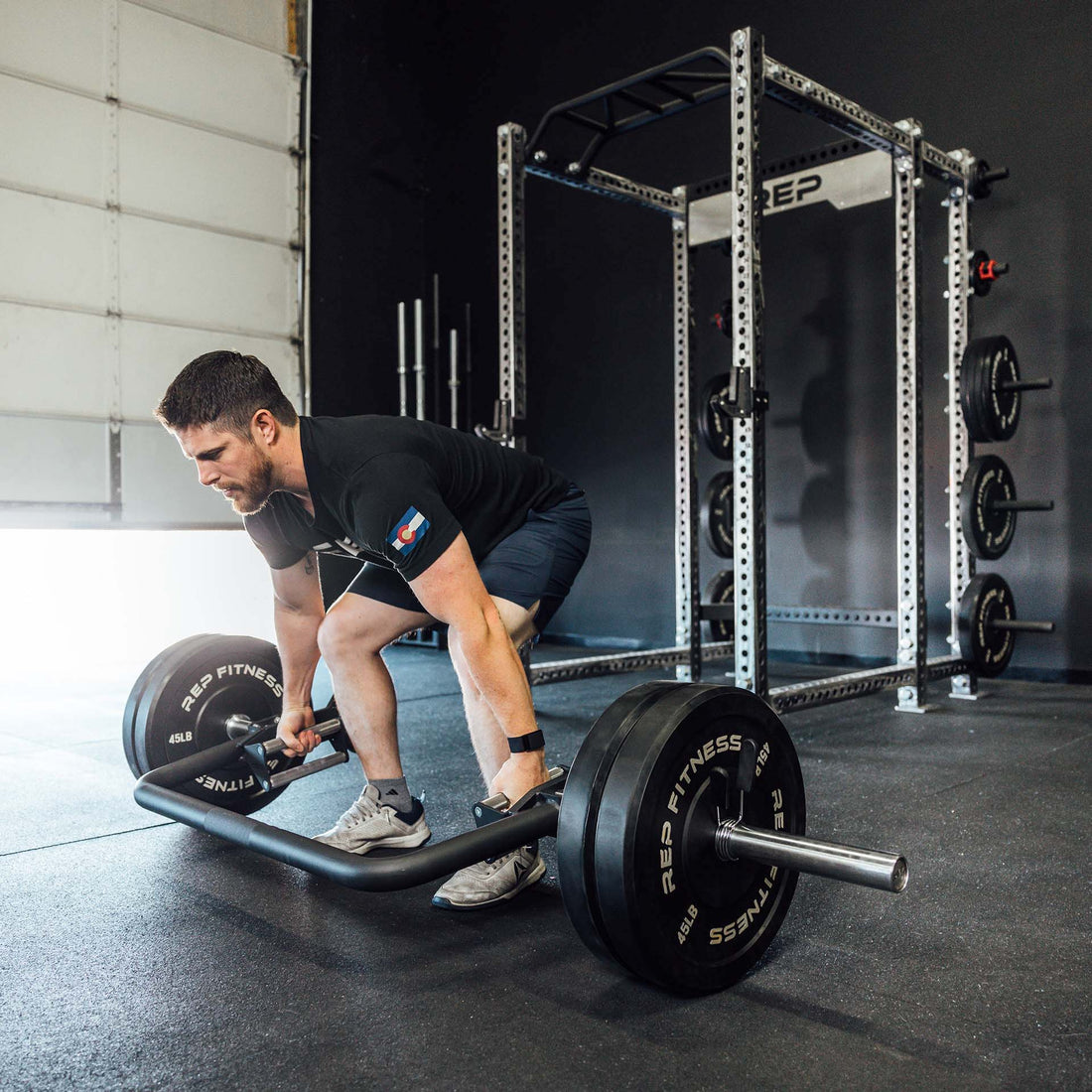
Apparently, it wasn’t enough to design the most versatile trap bar out there. Now, the Open Trap Bar has even more options, with four different handle attachments.
The Open Trap Bar was originally designed with handles that are easy to remove using a simple thumbscrew. This allows lifters to use it as a cambered bar for presses and squats. But it also allows you to swap out the handles with other options.
Trap Bar Handles
Here’s a look at the different Open Trap Bar handles and their various benefits.
The Original Handles
The handles the Open Trap Bar was originally released with are fully knurled and stainless steel. Like all trap bar handles, they’re also neutral grip, meaning your palms are facing toward each other.
Each handle offers two heights: a high and low option, for a higher or lower starting point to create different challenges. When the bar is loaded, the low, “in-line” handles stand 8.3” from the floor. The loaded height of the high handles is 11.3” from the floor – so a good 3 inches higher. (That may make the lift feel easier – less range of motion. Don’t come at me, sumo bois.) These handles are 28mm thick, which is typical for a trap bar handle.
However, many lifters said they felt the handles were too far apart (27.3” handle to handle), creating a wider grip than is normal for a trap bar. This sparked the innovation of more options.
Wide Grip Handles
The original handles the Open Trap Bar came with are now considered the Wide Handles. The “wide” refers to the distance between the two handles, not the diameter of the handle itself.
At 27.3” from handle to handle, these are ideal for lifters with broad shoulders. A wider hand placement also demands more upper back and traps. The wider grip puts your chest lower toward the ground. This creates a lower starting point, almost like a deficit pull.
Needless to say, a wider grip is going to feel heavier for most lifters. But it’s an excellent challenge; a way to really hit that upper back; and can be beneficial in cross-training for Olympic weightlifting lifts that have a wider hand placement.
The Wide Handles themselves weigh 12.8lbs for the pair. They also feature a low and high option.
Standard Grip Handles
Now, the Standard Handles better adhere to what you’d typically expect on a trap bar. Like the Wide Handles, they’re still neutral grip and 28mm thick. Only these handles are slightly closer together: 25” from handle to handle.
This makes these handles comfortable for most lifters of all sizes and creates a lifting experience you’re familiar with if you’ve used a trap bar before.
The Standard Handles weigh 15.9lbs for the pair, and they have the low/high option.
Narrow Grip Handles
The “narrow” here refers to the distance between the two handles, not the diameter of the handles themselves. The Narrow Handles have the same diameter (28mm) with neutral positioning, except they’re closer together: 23" from handle to handle.
This is optimal for lifters with smaller frames – or just lifters who want to train with a narrower hand placement. A narrower grip will also give you a slightly higher starting point and a more upright torso.
The Narrow Handles themselves weigh 17.2lbs. Like the others, they also have a low or high handle option.
Rotating Handles
The “rotating” in these handles refers to the ability to quickly switch between different handle options – not the movement of the handles themselves; they do not spin or rotate when you are using them (like some grip sport handles do). You could think of Rotating Handles as a 3-in-1 handle.
These are awesome for training grip strength to create different challenges. The Rotating Handles have a 28mm diameter, a 38mm diameter, and an extra thick 48mm diameter handle to choose between. Once attached to the Open Trap Bar frame, you can instantly switch between the three thickness options – no more removing/screwing of anything.
Regardless of which thickness you opt for, the Rotating Handles sit approximately 24.6” from handle to handle (so, about the standard distance for a trap bar). However, due to their spinning design, they can sit a little wider or a little narrower, depending on your frame. They almost adapt to each lifter’s frame size.
The different handle widths are a fun choice because it’s quick and easy to change stimulus throughout your workout. But most of all, these are a grip party and a half. Grip training is a vital component of strength training, and it’s a predictor of your overall muscular strength, endurance, and other health factors.
Even if you’re not a Grip Sport competitor, personal trainer Miah Sanchez teaches his athletes it’s important to train grip, just like you’d train any other muscles.
“It doesn’t matter how strong your back is, once your forearms go, you’re out,” says Sanchez, who has been a trainer for nine years. “Grip is one of the first things to fatigue when you’re lifting.”
He likens the body to a game of chess: the smaller pieces (or muscles) get knocked out first. So, it’s hard to truly tax your back and legs on a trap bar if your grip is too weak to support a challenging load for the rest of your body. The thicker the handles, the harder it is on your grip, and the less weight you’re probably going to be able to pull, Sanchez says.
For a fun programming idea, he says to try a sort of drop set, but with handle width instead of weight. Load up the bar with a good amount of weight that you can carry – but not easily -- with the fattest handles. Perform a farmer’s carry with that weight and the thickest handles. When you fail, drop down to the medium-diameter handles and run that weight as far as you can. When that fails, flip to the thinnest handles and see how far you can go.
“Grip strength can be a lot of fun,” Sanchez says.
The Rotating Handles weigh the most (naturally, there are three of them), at 34lbs for the pair. So, make sure you add that onto your total. These don’t have a low/high option, due to their carousel design.
Note: All handle attachments only work on the Open Trap Bar, not the regular Trap Bar. And all handles are made from stainless steel, except the Rotating Handle, which is steel with a hard-chrome finish.
How to Change the Handles
It’s super simple to swap out the handles. You can loosen the washer by hand or use the tool that comes with the Open Trap Bar. Loosen it just enough to slide the old handles off and the new ones on. You’ll notice the attachment point of the handles has a sort of key-shaped opening that slides securely onto the trap bar.
You can use the tool to attach them extra tight, if you prefer less shaking during the lift. But even hand-tightened handles should be secure enough to handle whatever load you throw at them. The static rating of the Open Trap Bar is 1,350lbs with whichever handle you choose.
So yeah, it’s tough enough for even the toughest lifter (and if you’re maxing out that 1,350lbs, go ahead and tag us on IG because we want your autograph).

NEWSLETTER SIGNUP
Product launch information, promotions, blogs, and REP news.

